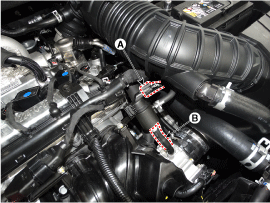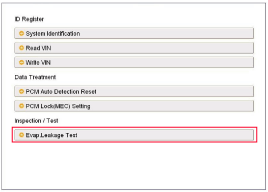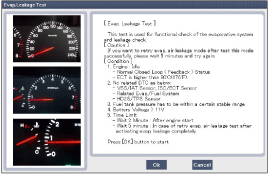Hyundai Kona: Evaporative Emission Control System / Repair procedures
Hyundai Kona (OS) 2018-2024 Service Manual / Emission Control System / Evaporative Emission Control System / Repair procedures
| Inspection |
[System Inspection]
| 1. |
Disconnect the vapor hose from the intake manifold and connect a vacuum
pump to the nipple on the intake manifold.
|
| 2. |
Check the following points with applied vacuum at the purge control
solenoid valve (PCSV).
|
[PCSV Inspection]
| 1. |
Turn ignition switch OFF and disconnect the negative (-) battery cable.
|
| 2. |
Disconnect the PCSV connector (A).
|
| 3. |
Disconnect the vapor hose (B) which is connected to the intake manifold
from the PCSV.
|
| 4. |
After connecting a vacuum pump to the nipple, apply vacuum.
|
| 5. |
With the PCSV control line grounded, check the valve operation with
battery voltage applied to the PCSV (Open) and removed (Closed).
|
| 6. |
Measure the coil resistance of the PCSV.
|
[EVAP. Leakage Test]
| 1. |
Select "Evap. Leakage Test".
|
| 2. |
Proceed with the test according to the screen introductions.
|
 Schematic diagrams
Schematic diagrams
Schematic Diagram
Canister
The Canister is filled with charcoal and absorbs evaporated fuel vapor from
the fuel tank. The gathered fuel vapor in canister is drawn into the i ...
 Canister Repair procedures
Canister Repair procedures
Removal
1.
Turn ignition switch OFF and disconnect the negative (-) battery cable.
2.
Lift the vehicle.
3.
Dis ...
Other information:
Hyundai Kona (OS) 2018-2024 Service Manual: Knock Sensor (KS) Description and operation
Description
Knocking is a phenomenon characterized by undesirable vibration and noise and
can cause engine damage. Knock Sensor (KS) is installed on the cylinder block
and senses engine knocking.
When knocking occurs, the vibration from the cylinder block is applied as pres ...
Hyundai Kona (OS) 2018-2024 Service Manual: Specifications
Specifications
Purge Control Solenoid Valve (PCSV)
▷ Specification
Item
Specification
Coil Resistance (Ω)
18.5 - 22.5 [20°C (68°F)]
Tightening Torques
Item
kgf.m
...
© 2018-2024 www.hkona.com



